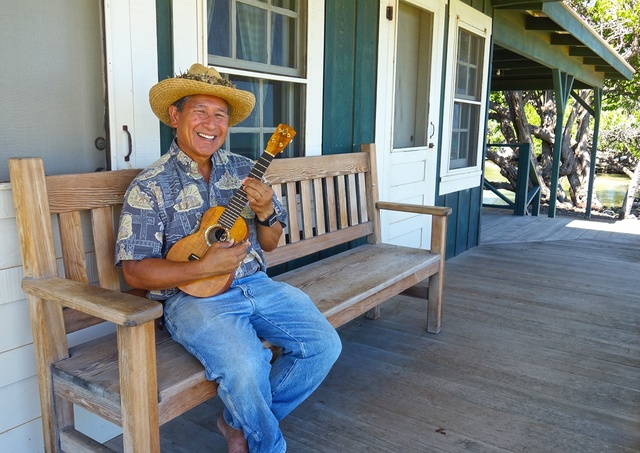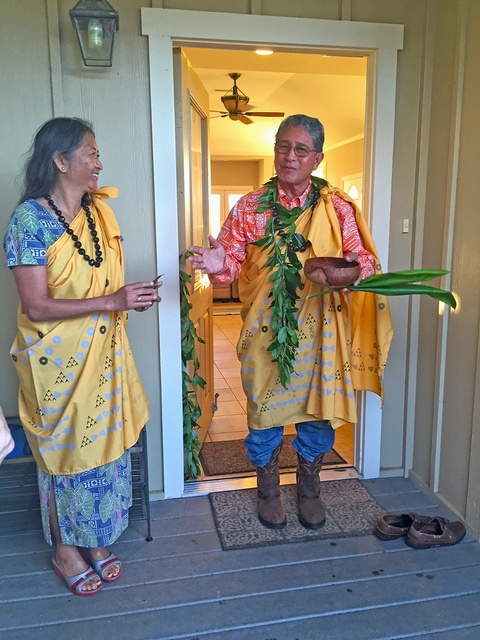KAHU
“I almost got fired for talking with the guests,” Danny Akaka Jr. chuckled as he explained how his probation period was extended by his landscaping foreman at the Mauna Lani Resort some 33 years ago because he was spending too much time talking with guests who came to him with questions about the history of the property.
Today his work is to talk.
Akaka, cultural historian for the Mauna Lani Resort for the past 16 years, stays busy with the monthly Twilight at Kalahuipuaa event, historical walking tours and groups of visitors, especially school children who seek his knowledge.
But he and his wife Anna, who volunteers much of her time at Mauna Lani as part of the cultural team, are also much sought after by the community-at-large. They travel near and far to provide support in the form of Hawaiian blessings, wedding ceremonies, memorial services and, at times, spiritual counseling.
“Never did I think it would come to this,” Akaka explained with a smile. “I thought I would be a Waikiki beach boy.”
Twilight at Kalahuipuaa inspiration
Anna recalls when, in 1972, as Hawaiian language students of Dr. Larry Kimura, she and Danny came with a handful of others to collect oral histories from kupuna whose traditional Hawaiian work and life stories were vanishing.
With no highway then built, they traveled to Puako and called over the chain link fence for permission to cross to Kalahuipuaa, which is now Mauna Lani Resort. During the day they worked alongside Uncle Abraham and Auntie Emily Kihe, the kupuna couple who spoke mostly Hawaiian and tended the ancient fish ponds and property.
Tasked with documenting ahele aama, a daytime method of catching the black aama crab that scampers on the lava outcroppings along the sea’s edge, they focused on Auntie Emily who was especially good at snaring the eyes of the aama crab using a long bamboo pole set up with coconut
leaf midribs and 20-pound thread to create a snare.
According to Danny, at sunset as they gathered for dinner, the storytelling would begin and the instruments would come out. “And there would be hula,” added Anna.
Inspiration for Mauna Lani’s Twilight at Kalahuipuaa started here, though these college students, who later became a couple, had no idea then how the path would unfold.
Mauna Lani evolution
In the early ‘70s, Akaka traveled the world as a musician with flight attendants who also danced hula, spreading the word of aloha through music and dance while he worked for Aloha Airlines.
When he and Anna married, he requested less travel. Aloha Airlines placed him in Kailua-Kona as a ticket agent, with occasional requirements to hop on a plane and share some aloha on behalf of the airline.
Like many airlines, things got tight in the ‘80s and layoffs happened. Akaka found himself working construction and then landscaping at Mauna Lani Resort.
“I’d never thought of myself as an employee of a hotel … I’m an entertainer,” he told himself. Akaka thought this would be a thing to bide his time until something else came along.
Something else came along, all right.
In response to hotel guests’ interest and to preserve his landscaping job, Akaka began conducting walking tours on his own time after work. The hotel noticed his efforts and how well the guests responded to him, and gave Akaka the title historian and assigned him to guest services with the department’s director, Pinky Crowe, and the children’s programs.
Soon, Akaka developed more tours, and enhanced the fishpond tour while also caring for the ponds.
For icing on the cake, Anna’s brother, Tim Lui-Kwan, worked for Bishop Estate doing archaeological and anthropological research on the area, and spent time with Akaka sharing detailed history about the property.
Occasionally Pinky asked Akaka to perform at weddings. One day, she told him about a request for a Hawaiian wedding.
“There are people who do that, Pinky,” he said. She responded, “No, they want a Hawaiian wedding done completely in Hawaiian language.”
Akaka protested, “I’m not a minister. I’ve never done this before. I’m just a wedding singer.” But Pinky replied, “You can do anything!”
He put together a purely Hawaiian language wedding ceremony for Jim Davis, the creator of cartoon strip “Garfield” and his bride. That was a big first step for Akaka, but soon his style of wedding ceremony was in demand.
Ceremonies and mentors
The Akakas learned much from John Kaimikaua, a local kumu hula, chanter and composer. His cultural ceremonial knowledge of practices and chants that he shared with them profoundly influenced the ceremonial aspects of their work today.
Native Hawaiians will often tell them, “We’ve never seen that before,” Akaka said, “These practices were put on a shelf years ago and now we’re taking them off the shelf and breathing life into them. Traditional Hawaiian blessings or weddings is our way of being able to impart this knowledge, our way of sharing the rich cultural heritage not only with the visitors but also with kamaaina.”
When Akaka was invited to be part of the planning for the building of the Mauloa canoe two decades ago, he initially felt like an outsider since he wasn’t a builder or kupuna. Considered a kumu hula as well as a kahu, Kelii Taua recognized Akaka’s genuine interest and sincerity and chose him to be the kahu for the canoe.
That role led to voyages on the Hokulea and serving as its protocol advisor.
The number and significance of requests for blessings, ceremonies and services grew. With great respect for his uncle and mentor, Pastor Abraham Akaka of Kawaiahao Church in Honolulu, Akaka sought his counsel on the direction his work was going. Without his uncle’s blessing, Akaka says he would not be involved in the spiritual aspects of his work today.
He knew his uncle wanted him to follow in his footsteps, but he had not felt the calling. Pastor Akaka told him, “You know, even before the missionaries came, the Hawaiian people always had the spirit of God in their hearts and you are just continuing that work. God’s work has already started and you have just taken a different route.”




